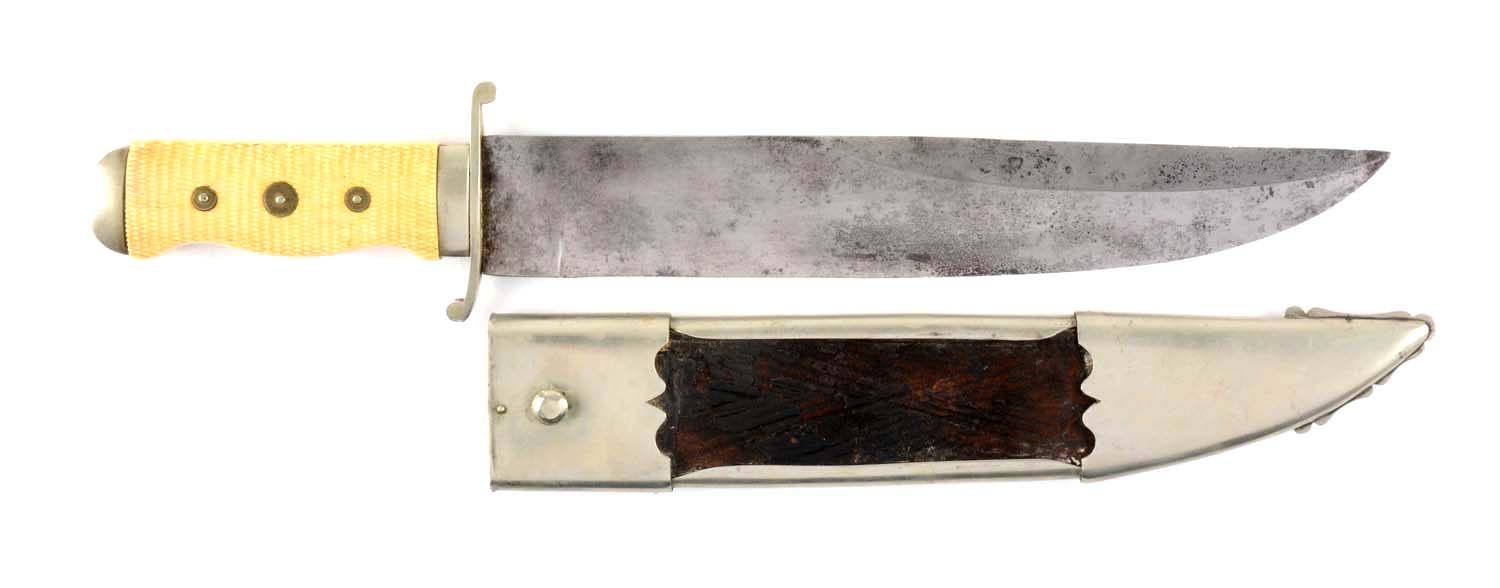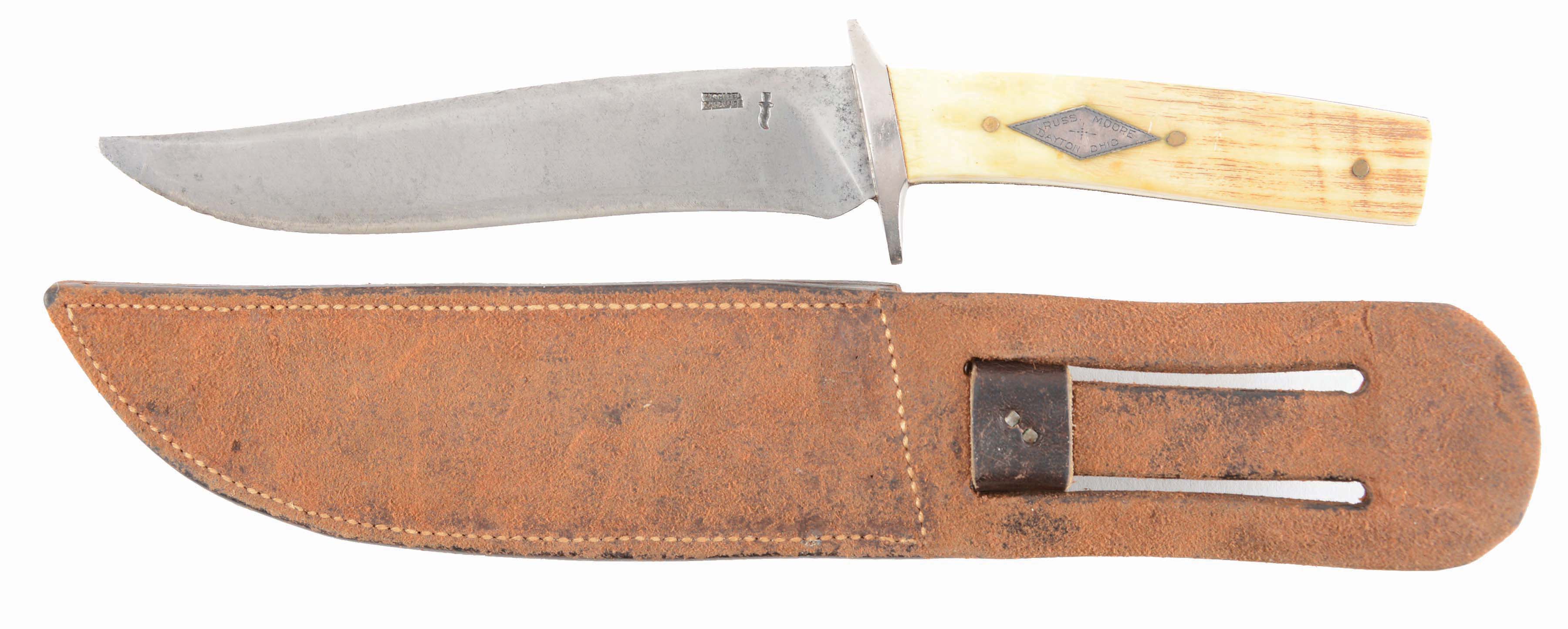with curved blade formed with a clipped point, engraved with an eagle displayed, ?None are genuine but those marked I.XL.?, the maker?s details and presentation inscription, iron cross-guard with scrolling terminals, Indian style carved brown hardstone grip, in its leather-covered wooden scabbard (light wear, chape missing), 30.2 cm blade Literature David Hayden-Wright, The Heritage of English Knives, Atglen, Pennsylvania, 2008, p. 234. The presentation inscription reads: John Campbell Surgeon Jalapa 1847 in Highest Esteem. On 18th April 1847 a force of thirteen thousand Mexican troops met nine thousand Americans at a mountain pass near Jalapa. Bitter hand-to-hand fighting ensued and the Mexicans were forced to flee. The American army continued, under General Winfield Scott, towards Mexico city, storming a Mexican fortress at Contreras and then routing a large Mexican force at Churubusco. It is likely that the founder of George Wostenholm & Son Ltd was George Wolstenholme (1775-1833), a fork maker at Thomas Lane. Apprenticed to John Micklethwaite, a cutler, in 1790 and granted his Freedom in 1799, George later moved to Broad Lane where he made spring knives. He was first listed in a Sheffield directory in 1816 as a pen and pocket knife manufacturer at Rockingham Street, where he had registered a silver mark in 1809. His workshops expanded to become Rockingham Works and he apparently shortened his name to ?Wostenholm? to facilitate its stamping on blades. His son, George Wostenholm (1802-1876) was apprenticed to his father and they are described in 1825 as ?George Wolstenholme & Son, manufacturers of table knives, and forks, pen, pocket, and sportsman?s knives, and general dealers in cutlery, 78 Rockingham Street?. George Wostenholm became a Freeman in 1826, a practical cutler and a dynamic salesman he found scope for his prodigious energy in America where, in 1830, the father and son launched a partnership with William Stenton, an experienced cutlery merchant. However, this did not last and the partnership was dissolved the following year when they were also granted their trademark ?I*XL. ?, bought by George Senior in 1826 and originally granted to William Aldam Smith in 1787. In 1833 George Senior died and the business continued under his son who opened a New York office in 1844, and by the middle of the century had agents in Philadelphia and Boston. America was the ideal market with its expanding frontier and enormous demand for folding knives, razors, and weapons. The firm?s trade became almost exclusively American and Wostenholm made little attempt to nurture other markets. In 1848 the Washington Works was acquired and American orders continued to roll in. The workforce increased significantly to 850 in 1861, having been around a hundred or so in the 1830s. The high quality of the firm?s Bowie and spring knives was achieved by ?drilling?, in which every knife was critically examined. It had the desired effect and soon ?I*XL? vied with Rodgers? star and Maltese cross as a badge of quality. Like Rodgers, Wostenholm made its share of exhibition pieces. At the Great Exhibition in 1851 Wostenholm displayed a set of ornate sheath knives, including one commissioned from the well-known artist Alfred Stevens The company also displayed a collection of exhibition multi-blades. The display won a Prize Medal for Wostenholm. The firm also carried off prize medals at exhibitions in Paris (1855) and London (1862). George Wostenholm had remarkable stamina. In early 1869, in his late sixties, he set off for a tour of Europe and in October the same year he made another trip to New York. In 1872, he again visited New York. He was active until the end, though he sold out to his business associates in 1875, when Wostenholm?s became a limited liability company. George Wostenholm died in 1876, aged 74 and left a remarkable fortune of nearly ?250,000. The new company chairman and directors had little or no experience of
with curved blade formed with a clipped point, engraved with an eagle displayed, ?None are genuine but those marked I.XL.?, the maker?s details and presentation inscription, iron cross-guard with scrolling terminals, Indian style carved brown hardstone grip, in its leather-covered wooden scabbard (light wear, chape missing), 30.2 cm blade Literature David Hayden-Wright, The Heritage of English Knives, Atglen, Pennsylvania, 2008, p. 234. The presentation inscription reads: John Campbell Surgeon Jalapa 1847 in Highest Esteem. On 18th April 1847 a force of thirteen thousand Mexican troops met nine thousand Americans at a mountain pass near Jalapa. Bitter hand-to-hand fighting ensued and the Mexicans were forced to flee. The American army continued, under General Winfield Scott, towards Mexico city, storming a Mexican fortress at Contreras and then routing a large Mexican force at Churubusco. It is likely that the founder of George Wostenholm & Son Ltd was George Wolstenholme (1775-1833), a fork maker at Thomas Lane. Apprenticed to John Micklethwaite, a cutler, in 1790 and granted his Freedom in 1799, George later moved to Broad Lane where he made spring knives. He was first listed in a Sheffield directory in 1816 as a pen and pocket knife manufacturer at Rockingham Street, where he had registered a silver mark in 1809. His workshops expanded to become Rockingham Works and he apparently shortened his name to ?Wostenholm? to facilitate its stamping on blades. His son, George Wostenholm (1802-1876) was apprenticed to his father and they are described in 1825 as ?George Wolstenholme & Son, manufacturers of table knives, and forks, pen, pocket, and sportsman?s knives, and general dealers in cutlery, 78 Rockingham Street?. George Wostenholm became a Freeman in 1826, a practical cutler and a dynamic salesman he found scope for his prodigious energy in America where, in 1830, the father and son launched a partnership with William Stenton, an experienced cutlery merchant. However, this did not last and the partnership was dissolved the following year when they were also granted their trademark ?I*XL. ?, bought by George Senior in 1826 and originally granted to William Aldam Smith in 1787. In 1833 George Senior died and the business continued under his son who opened a New York office in 1844, and by the middle of the century had agents in Philadelphia and Boston. America was the ideal market with its expanding frontier and enormous demand for folding knives, razors, and weapons. The firm?s trade became almost exclusively American and Wostenholm made little attempt to nurture other markets. In 1848 the Washington Works was acquired and American orders continued to roll in. The workforce increased significantly to 850 in 1861, having been around a hundred or so in the 1830s. The high quality of the firm?s Bowie and spring knives was achieved by ?drilling?, in which every knife was critically examined. It had the desired effect and soon ?I*XL? vied with Rodgers? star and Maltese cross as a badge of quality. Like Rodgers, Wostenholm made its share of exhibition pieces. At the Great Exhibition in 1851 Wostenholm displayed a set of ornate sheath knives, including one commissioned from the well-known artist Alfred Stevens The company also displayed a collection of exhibition multi-blades. The display won a Prize Medal for Wostenholm. The firm also carried off prize medals at exhibitions in Paris (1855) and London (1862). George Wostenholm had remarkable stamina. In early 1869, in his late sixties, he set off for a tour of Europe and in October the same year he made another trip to New York. In 1872, he again visited New York. He was active until the end, though he sold out to his business associates in 1875, when Wostenholm?s became a limited liability company. George Wostenholm died in 1876, aged 74 and left a remarkable fortune of nearly ?250,000. The new company chairman and directors had little or no experience of















Try LotSearch and its premium features for 7 days - without any costs!
Be notified automatically about new items in upcoming auctions.
Create an alert